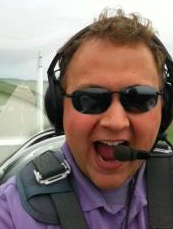By: Al Waterloo (KingAirNation Username: @Al_Waterloo) 
It was 5 am and I couldn’t believe it. The welcoming agent at FlightSafety was smiling and really happy to see me and my co-worker. What an impressive start, and the agent’s smile would carry through my remaining stay. But, let’s be honest, nothing at 5 am is really easy when you know you are going to be run through the ringer in the King Air simulator. My job as a corporate pilot requires that I complete annual training to maintain my skills in the plane I fly, a Beech King Air 200.
So here I was in Wichita, KS home to FlightSafety’s King Air training program for a week of learning and renewal. During my time there I learned a lot about the King Air that I never knew; things I never really thought about before. It wasn’t all just about improving safety. It wasn’t airframe limitations, operating specs, or even emergency memory lists … anyone can teach that if they have Power Point. What I learned at FlightSafety nobody has EVER been able to teach me – – how to make urgent critical flight decisions in the King Air. These decisions aren’t to be taken lightly. Pilots need to be proficient in making them. They need to think about them. They need to study them.
“Why?” you might ask. Isn’t it a given that the pilot will always try and protect themselves, passengers and airplane in all situations? Well, let’s agree that these decisions are a matter of life or the alternative. And FlightSafety training makes you practice making these absolutely critical decisions, which pays dividends on your understanding of the King Air. How did it pay dividends? Well it made me understand what the awesome capability of the King Air really is. If you get stuck between a rock and a hard place, there really is no other airplane I’d want on my side helping me. Imagine if you were taking off in a fully loaded King Air 200 out of a 3,000 ft. runway. It’s hot, and humid. As you were on the take-off roll, you lost an engine at VMC – 86kts. Rotation and V1 speed was 95kts. What would you do?
Actually, let me ask you this, would you rather be in a King Air or its counterpart, the Mitsubishi MU-2. The answer to ‘what would you do?’ is a really hard answer. There isn’t a right or a wrong answer, but it pays dividends if you know what your airplane will do for you. FlightSafety understands the responsibility a King Air pilot has. You’ll have a hard time finding more King Air knowledge under one roof. Given an emergency situation in the simulator, I got the chance to make a decision and respond. I got to see the result of my actions while in the safety of an air-conditioned facility safely anchored on the ground. Then I could benefit from advice my trainer gave me and try it all again to see if I could get a better result. Not only was I gaining new knowledge about a plane I flew on a regular basis, I was immersed in the experiences that are found only at certain moments … when you least expect (or, want) them.
As a pilot, I see that knowledge base and experience as low hanging fruit for the picking! To help identify the fruit your diet needs, the trainers at FlightSafety want you to ask questions. They build your learning experience around your skill level and the daily challenges you face. I can guarantee that if you take this training you’ll be handsomely rewarded with a relationship that you have never had before with your King Air. So, you don’t fly a King Air? My apology. But, I’m willing to bet that there is a FlightSafety program for your bird, too. This training is worth getting up at 5 am.
 Al Waterloo is the co-founder of SimpleFlight.net and host of SimpleFlight Live Radio Show. His aviation addiction became a problem when he got points taken off in Creative Writing class for writing too many poems about aviation. He currently flies a KingAir B200GT. Find him on KingAirNation: @Al_Waterloo Find him on Twitter: @AL_H2OLoo
Al Waterloo is the co-founder of SimpleFlight.net and host of SimpleFlight Live Radio Show. His aviation addiction became a problem when he got points taken off in Creative Writing class for writing too many poems about aviation. He currently flies a KingAir B200GT. Find him on KingAirNation: @Al_Waterloo Find him on Twitter: @AL_H2OLoo

